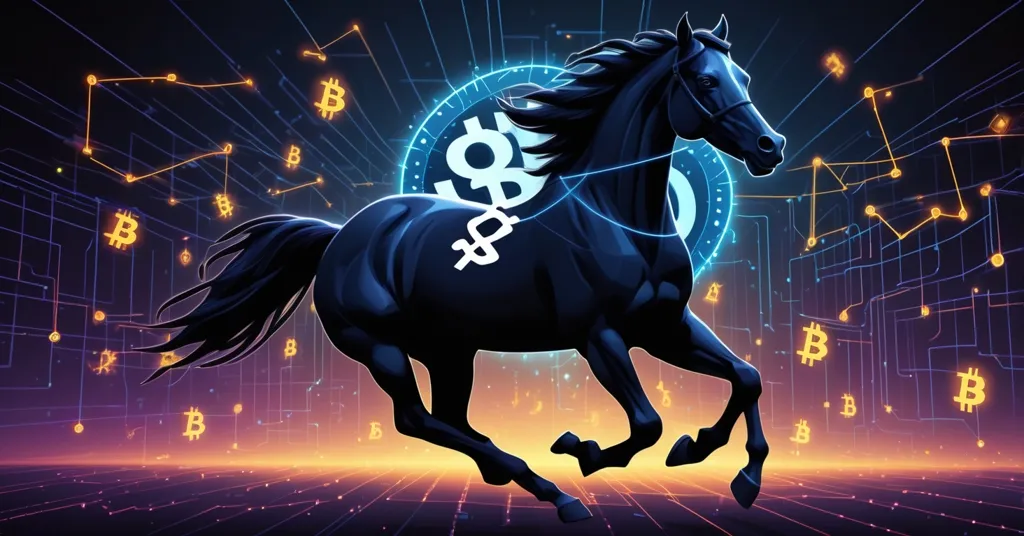Mutuum Finance (MUTM) Presale: DeFi Dark Horse or Dangerous Gamble Under $0.05?

Mutuum Finance (MUTM) Presale: Explosive Potential Under $0.05 or Risky Crypto Gamble?
A new DeFi token priced at just pennies is turning heads with bold claims of outpacing giants like Solana (SOL) in short-term gains. Mutuum Finance (MUTM), currently in its presale phase, has raised millions and drawn thousands of investors—but is this a groundbreaking opportunity or another speculative trap in the volatile crypto market? Let’s dig into the hype, the numbers, and the hard truths.
- Mutuum Finance (MUTM): Presale Phase 6 at $0.035, over 95% sold out, raising $18.85M from 18,120+ investors.
- Solana (SOL): Bouncing back from a 25% drop, with bullish signals pointing to $180-$200 potential.
- Core Debate: MUTM’s low price and DeFi promise vs. Solana’s proven stability—where’s the smarter play?
Mutuum Finance: Hype or Substance in the DeFi Space?
Mutuum Finance (MUTM) is the latest contender in the decentralized finance (DeFi) arena, a sector of crypto that builds financial tools on blockchain technology to bypass traditional middlemen like banks. Priced at a mere $0.035 per token during Phase 6 of its presale, MUTM has already sold over 95% of this round and is gearing up for a 20% price hike to $0.04 in Phase 7. The project boasts an impressive war chest of $18.85 million raised from more than 18,120 individual investors, numbers that suggest significant market confidence—or perhaps just a classic case of fear of missing out driving impulsive buys. For more on its potential, check out this detailed analysis of Mutuum Finance’s explosive growth prospects.
At its core, MUTM aims to be a lending and borrowing platform. In simple terms, this means users could lend their crypto assets to earn interest, much like a savings account, or borrow against their holdings as collateral for loans, all without a bank’s involvement. The token operates on an interest-based model, implying that holding or staking MUTM—locking up tokens in the platform to support operations—could yield returns over time. However, specifics on interest rates, staking mechanics, or even risk mitigation for borrowers defaulting remain murky at this stage. For newcomers, DeFi platforms like this promise financial freedom and self-custody, but they often come with steep learning curves and hidden risks, from smart contract bugs to outright scams.
One of MUTM’s standout moves is accessibility. The team recently introduced credit and debit card payment options for token purchases, a feature that lowers the entry barrier for those unfamiliar with crypto wallets or exchanges. This aligns with a broader push in the industry to onboard mainstream users, especially as regulatory scrutiny tightens around crypto’s less user-friendly aspects. Additionally, MUTM is prepping for a testnet launch on the Sepolia network, a testing ground for Ethereum-based projects. This phase will simulate lending, borrowing, and repayment features to stress-test security and functionality before a full rollout. If successful, it could signal credibility for a 2025 launch—but let’s be real, a testnet is just a sandbox. Many projects hype early milestones only to flop when real users and real money hit the system.
So, what sets MUTM apart in a crowded DeFi field with players like Aave and Compound? Frankly, it’s too early to say. Unlike competitors with billions in total value locked (TVL)—a metric for assets committed to a protocol—MUTM is still a blueprint. Its roadmap hints at scalability and user-focused design, but without audits, team transparency, or a live product, it’s a gamble dressed in shiny promises. The $18.85 million raised is eye-catching, sure, but big bucks don’t equal big results. Just ask the countless presale investors burned by projects that vanished post-fundraise.
Solana’s Steady Climb: A Proven Benchmark
While MUTM rides on potential, Solana (SOL) operates on pedigree. Solana is a high-speed blockchain platform designed for scalability, often pitted against Ethereum for its lower transaction fees and faster processing—think of it as a highway for decentralized apps (dApps) like NFT marketplaces and DeFi protocols. Recently, SOL took a 25% hit, sliding from a peak of $173, likely due to market-wide profit-taking or macro jitters. Yet, it’s showing signs of a comeback with what traders call a V-shaped recovery, a sharp bounce-back pattern on price charts signaling renewed buying interest.
For those less familiar with market lingo, Solana’s momentum is backed by indicators like the Relative Strength Index (RSI), a tool to spot if an asset is overbought (due for a drop) or oversold (ripe for a rise). RSI for SOL has climbed from 28 to 50, moving from oversold territory to neutral ground, hinting at bullish strength. Historically, a support level at $130 has been a launchpad for massive rallies—108% to $265 in late 2024 and 98% to $250 in early 2025. If SOL holds key levels, a push to $180 or even $200 isn’t far-fetched, especially with its robust ecosystem of projects like Raydium (a DeFi exchange) and Serum (a derivatives platform) driving real usage.
Unlike MUTM, Solana isn’t selling a dream—it’s delivering a product. Its blockchain supports thousands of transactions per second, a feat that’s attracted developers and users despite past network outages. That said, Solana isn’t without flaws; its higher price point means less explosive short-term gains compared to a presale token, and occasional instability has drawn criticism. Still, it’s a battle-tested name in a sea of unproven newcomers, offering a yardstick for what MUTM must achieve to justify the buzz.
The Bigger Picture: DeFi Trends and Risks in 2025
Zooming out, MUTM’s rise reflects a broader wave in the DeFi sector, which has exploded in recent years as users seek alternatives to traditional finance. Lending and borrowing protocols alone hold over $50 billion in TVL as of late 2024, per data from DeFi Pulse, with platforms enabling everything from yield farming (earning rewards by providing liquidity) to flash loans (uncollateralized borrowing for quick trades). MUTM’s focus on this niche taps into a growing demand for decentralized credit systems, especially in regions underserved by banks. By 2025, analysts predict DeFi could double in size if adoption continues—provided regulatory headwinds don’t derail the party.
Speaking of regulation, DeFi faces a gauntlet. Governments worldwide are cracking down on crypto’s anonymity and lack of oversight, with potential rules around know-your-customer (KYC) mandates or taxation on lending yields. For MUTM, launching a lending platform amidst this uncertainty adds a layer of risk beyond code bugs or market dumps. Smart contract vulnerabilities—flaws in the programming that runs DeFi protocols—have cost users billions in hacks, and presale projects rarely have the battle scars to prove their defenses. Investors eyeing MUTM must weigh these systemic challenges against the seductive lure of a low entry price.
Bitcoin’s Lens: Decentralization Over Hype
As Bitcoin maximalists, our core belief is that Bitcoin stands as the pinnacle of decentralization, privacy, and financial sovereignty—a true middle finger to centralized control. Its unmatched security and store-of-value status make it the gold standard in this space. That said, we’re not blind to the roles altcoins and innovative protocols play. Solana’s speed fuels dApps that Bitcoin, by design, doesn’t prioritize, while DeFi projects like MUTM could, in theory, complement Bitcoin by enabling self-custodied borrowing or lending—key tenets of freedom if executed with transparency.
Yet, our skepticism runs deep. Bitcoin’s ethos is rooted in proven resilience, not untested promises. MUTM’s lending model might sound like a step toward financial inclusion, but without a track record, it’s just noise against Bitcoin’s signal. Solana, while useful, still pales in decentralization compared to BTC’s network. We champion disruption and effective accelerationism—pushing tech to reshape the status quo—but only when it’s grounded in substance. Presale hype like MUTM’s often smells of centralized cash grabs masquerading as progress. Prove us wrong with a working product, and we’ll listen.
Key Questions and Takeaways for Crypto Enthusiasts
- What is Mutuum Finance (MUTM), and why is it generating buzz?
MUTM is a DeFi token in presale at $0.035, centered on lending and borrowing, with $18.85 million raised from over 18,120 investors. Its low price and promised utility drive the excitement. - How does MUTM compare to Solana (SOL) for potential returns?
MUTM offers high-risk, high-reward short-term potential due to its presale status, while Solana provides steadier upside ($180-$200) with a proven ecosystem, though less immediate explosive gains. - Are presale DeFi projects like MUTM worth the risk?
Rarely—they’re a minefield of unproven tech, potential scams, and regulatory pitfalls. Dig into team background, audits, and roadmaps before even considering a bet. - How do altcoins and DeFi fit alongside Bitcoin’s dominance?
They fill gaps Bitcoin doesn’t target, like fast dApps (Solana) or lending (MUTM), driving innovation, but often lack BTC’s security and decentralized ethos. - Will MUTM’s accessibility features spur mass crypto adoption?
Credit/debit card purchases ease entry for newbies, which could help, but true adoption depends on a functional, trustworthy platform—something MUTM hasn’t yet proven.
The crypto space thrives on bold bets and boundary-pushing ideas, and Mutuum Finance could emerge as a dark horse if it nails execution. Its testnet launch on Sepolia will be a make-or-break moment—deliver a glitch-free, secure preview, and the hype might gain legs. Until then, it’s a speculative dart throw in a market littered with broken dreams. Solana’s recovery offers a safer harbor for those wary of uncharted waters, while Bitcoin remains the unshakeable north star of this revolution. We’re all for disrupting the status quo, but not at the cost of reason. Keep your wits as sharp as your wallet—due diligence isn’t just advice, it’s your shield. The future of finance is being forged, but not every player will survive the heat.



